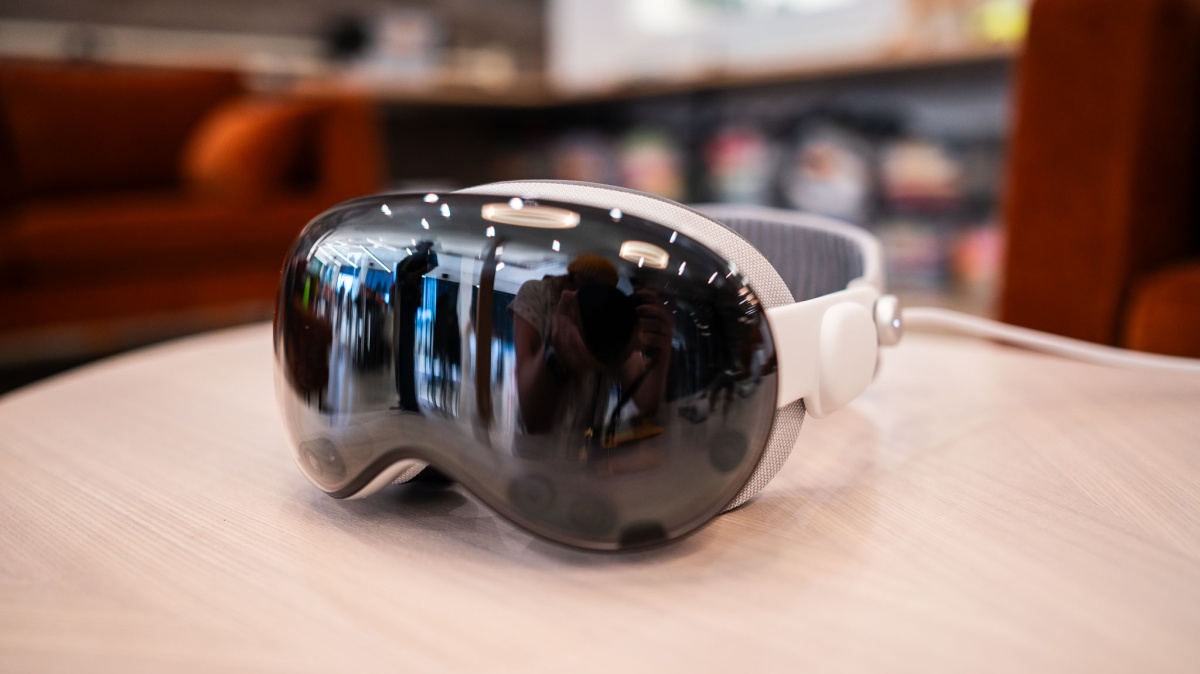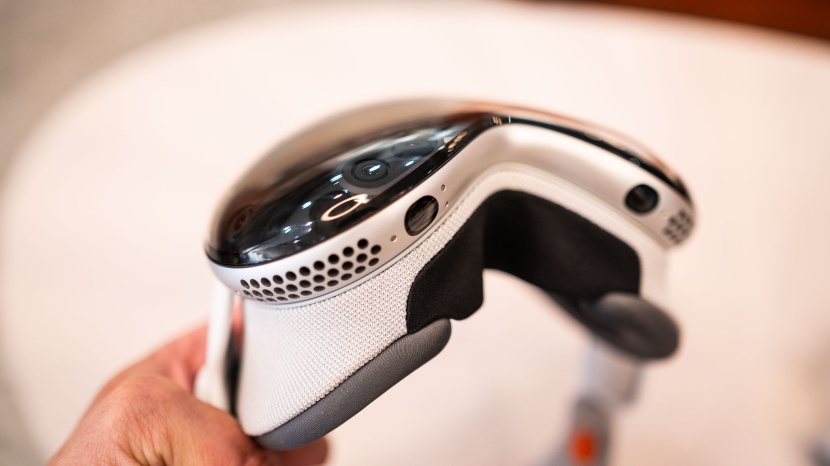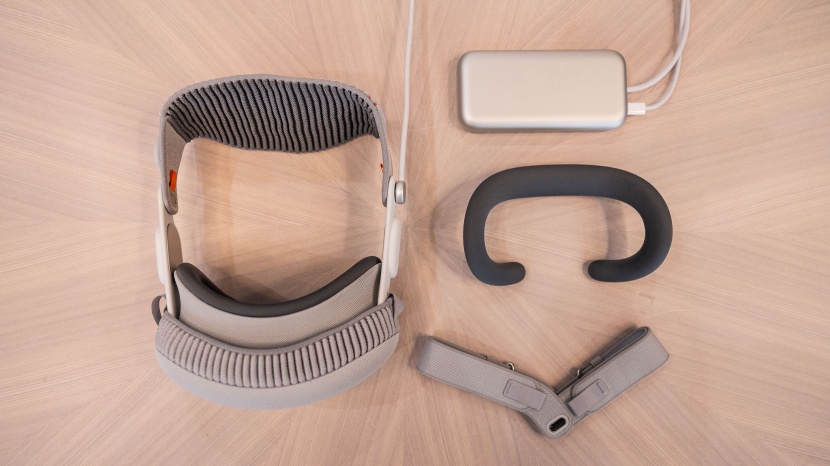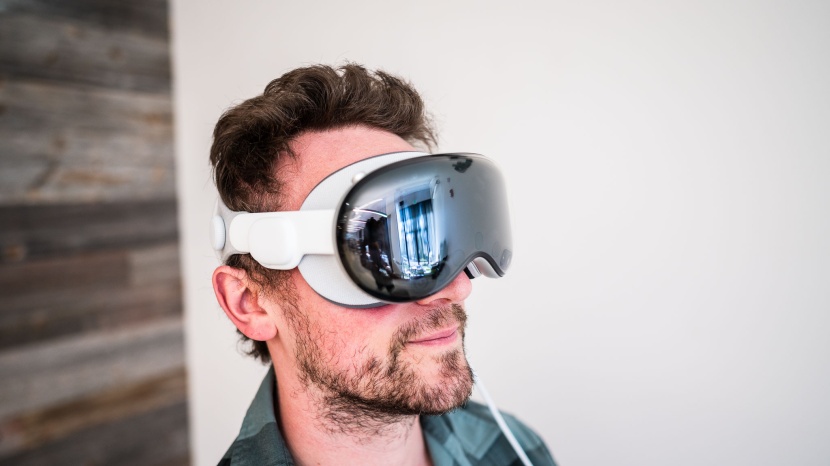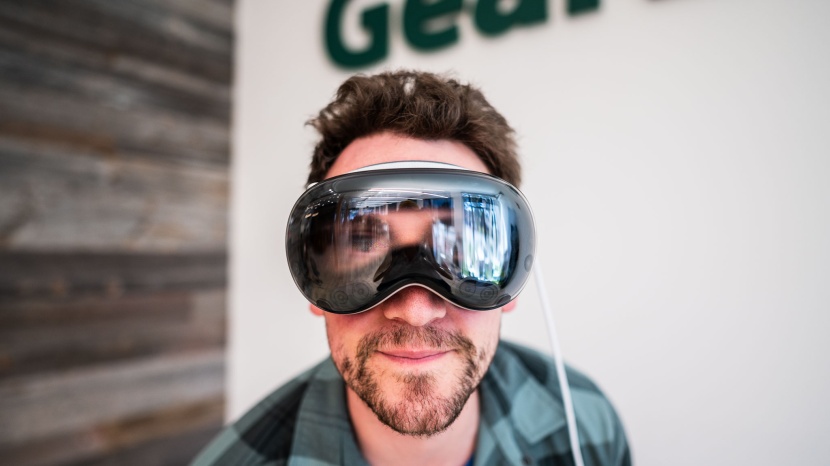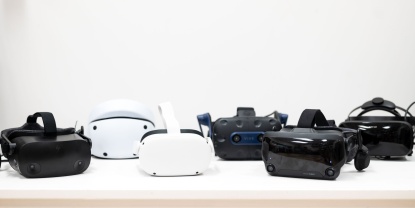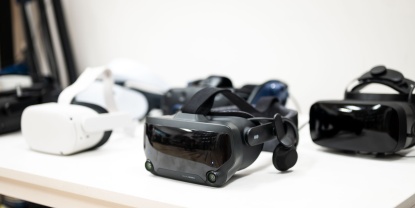Our Verdict
Compare to Similar Products
 This Product Apple Vision Pro | |||||
|---|---|---|---|---|---|
| Awards | Working and Relaxing | Runner Up Headset | Best Overall/Stand Alone | ||
| Price | $3,699 List | $999 List | $550 List $499.00 at Amazon | $500 List $499.99 at Amazon | $799 List $699.00 at Amazon |
Overall Score  |
|||||
| Star Rating | |||||
| Bottom Line | A sharp innovative (and expensive) display geared more toward browsing, work, and movie watching than gaming | A solid and high-performing VR headset that doesn't require a top-shelf GPU | This great value headset should excite PS5 players looking for upgraded VR immersion | One of the best standalone headsets on the VR market represents evolutionary improvements on the Quest 2 at a reasonable price | This headset will appeal to users with glasses or who require top-notch tracking precision |
| Rating Categories | Apple Vision Pro | Valve Index | PlayStation VR2 | Meta Quest 3 | Vive Pro 2 Headset |
| Tracking (35%) | |||||
| Comfort (30%) | |||||
| Visuals (15%) | |||||
| User Friendliness (15%) | |||||
| Ease of Setup (5%) | |||||
| Specifications | Apple Vision Pro | Valve Index | PlayStation VR2 | Meta Quest 3 | Vive Pro 2 Headset |
| Measured Weight | 1.37 lbs | 1.86 lbs | 1.31 lbs | 1.13 lbs | 1.94 lbs |
| Tracking type | Built-in Cameras | External Sensors | Built-in Cameras | Built-in Cameras | External Sensors |
| Per Eye Manufacturer Resolution | 3660 x 3200 | 1440 x 1600 | 2000 x 2040 | 2064 x 2208 | 2448 x 2448 |
| IPD Adjustment | Automatic IPD: 51 - 75mm | Mechanical IPD: 58 - 70mm | Mechanical IPD: 57 - 73mm *Rough measurement |
Mechanical IPD: 53 - 75mm | Mechanical IPD: 57 - 70mm |
| Measured Horizontal Field of View | 95º | 110º | N/A | 100º | 110º |
| Measured Vertical Field of View (Up) | 25º | 40º | N/A | 35º | 32º |
| Measured Vertical Field of View (Down) | 35º | 45º | N/A | 45º | 32º |
| Manufacturer Field of View | N/A | Optimized eye relief adjustment allows a typical user experience 20º more than the HTC Vive | 110º | 110º | Up to 120º |
| Manufacturer Refresh Rate | 90, 96, 100Hz | 80, 90, 120, 144 Hz | 90, 120 Hz | 72, 80, 90, 120Hz | 90, 120 Hz (only 90Hz supported via VIVE Wireless Adapter) |
| Sound | Built-in headband | Built-in, 37.5mm off-ear | 3.5 mm port, included earbuds Bluetooth connected via the Console |
Built-in headband 3.5 mm audio port optional |
Built-in, on or off-ear |
| Connection Type to PC | Wifi with a 3rd party workaround | - DisplayPort 1.2
|
- USB-C | Stand alone (Optional PC Connection: Meta Quest Link Cable and Air Link ) |
- DIsplayPort (DP to mini-DP adapter included)
|
| Room For Glasses | No | Below average | Excellent | Average | Above Average |
| Manufacturer Minimum PC Specs | N/A | OS: Windows 10 Processor: Dual Core with Hyper-Threading Memory: 8 GB RAM Network: Broadband Internet connection Additional Notes: Available DisplayPort (Version 1.2) and USB (2.0+) Port Required |
N/A Uses PS5 | Optional Link Cable Setup OS: Windows 10 / Windows 11 Processor: Intel i5-4590 / AMD Ryzen 5 1500X or greater Memory: 8GB+ RAM USB Port: 1 USB Port |
OS: Windows 11 / Windows 10 Processor: Intel Core i5-4590 or AMD Ryzen 1500 equivalent or greater Memory: 8 GB RAM or more Video Out: DisplayPort 1.2 or higher. DisplayPort 1.4 or higher with DSC is required for Full Resolution mode. |
| Manufacturer Minimum GPU | N/A | NVIDIA GeForce GTX 970, AMD RX480 | N/A Uses PS5 | Optional Link Cable Setup Supported GPUs: NVIDIA Titan X, NVIDIA GeForce GTX 970, NVIDIA GeForce GTX 1060 Desktop 6GB, NVIDIA GeForce GTX 1070(all), NVIDIA GeForce GTX 1080(all), NVIDIA GeForce GTX 1650 Super, NVIDIA GeForce GTX 1660, NVIDIA GeForce GTX 1660 TI, NVIDIA GeForce RTX 20-series (all), NVIDIA GeForce RTX 30-series Please Note: NVIDIA 3050 (laptop) and 3050ti GPUs are not recommended for use with Link. AMD 400 Series, AMD 500 Series, AMD 5000 Series, AMD 6000 Series, AMD Vega Series Please note: the Radeon RX 6500 is not recommended for use with Link. |
NVIDIA GeForce GTX 1060 or AMD Radeon RX 480 equivalent or greater. (Not full resolution) |
| Manufacturer Recommended PC Specs | N/A | Processor: Quad Core + Additional Notes: Available USB (3.0+) Port Required for Headset Pass-Through Camera & USB Port Support |
N/A Uses PS5 | Optional Link Cable Setup OS: Windows 10 / Windows 11 Processor: Intel i5-4590 / AMD Ryzen 5 1500X or greater Memory: 8GB+ RAM USB Port: 1 USB Port |
Better than Minimum Specs |
| Manufacturer Recommended GPU | N/A | NVIDIA GeForce GTX 1070 or better | N/A Uses PS5 | Optional Link Cable Setup Nvidia RTX 20 Series, AMD Radeon RX 6000 Series, or greater |
GeForce RTX 20 Series (Turing) or AMD Radeon 5000 (Navi) generations or newer required for Full Resolution mode. |
| Hardware Platform Needed | Stand alone | PC | PS5 (PlayStation 5) | Stand alone (optional tether to VR ready PC) |
PC |
Our Analysis and Test Results
Apple's Vision Pro truly excels if your goal is to escape into an immersive cinematic world. It also offers fun new ways to experience FaceTime, navigate apps, and view a virtual display for your Mac or iPad. You can modulate the pass-through opacity while interacting with all of these apps floating over your analog world and make your selections with a glance of your eyes and a pinch of your fingers. The remote control-free operation can be convenient. However, the tracking leaves much to be desired due to this modification.
Tracking
Coming in hot with a feature that differentiates the Vision Pro from most mixed-reality headsets, the interface is controlled by a user's eyes and hands rather than hand-held controllers. While not having to hold a controller can be freeing in some respects, the tradeoff is a sacrifice in accuracy. And despite the advanced IPD detection, eye tracking doesn't always equate to a seamless experience either. We found that recalibrating can sometimes help improve the situation.
There were a number of times during our tests that the tracking didn't activate when pressing fingers together, and the headset only seemed to track the index and thumb for pressing. One tester mentioned, “It is more natural to use my middle finger and thumb.” We also found on numerous occasions that the eye tracking didn't make the correct selection even when looking directly at the object in question. We tried closing alternate eyes, but that didn't resolve the issue. We wound up having to redo the eye scan or take the headset off and put it back on to reset the calibration whenever we ran into this problem. On the flip side, if things are working fine, sometimes taking the headset off and putting it back on would throw things out of whack, and we would have to recalibrate again.
The finger controls are purported to work while holding your hands in a comfortable position, like your lap, but we found that unreliable much of the time. On most occasions, repositioning our hands more directly in front of the headset made for a better experience. While playing games in SteamVR, there was lag and inconsistent responsiveness, and things could get horribly delayed or not work at all. In short, when it works, it works great; when it doesn't, it doesn't.
Comfort
Our comfort ratings are is based on number of factors, including how a headset feels on the face, perceived weight, breathability, and if you can wear glasses with the headset. We rated the Apple Vision Pro's comfort slightly above average for its comfy cushion and fabric, which we found pleasantly akin to a soft t-shirt. At 1.37 lbs, the Vision Pro is an average weight for the group, but forgoing the top head strap translates to more weight felt on the face. An external battery sits on the left side of the device and adds a bit of weight there. This is also where the cable connects to the headset, but it was so light that we never noticed any tugging when moving around.
When shaking our heads vigorously, the headset would move a fair bit. With quick movements to the left and right, it stayed decently well in place without smashing into our noses. After laying on the couch while wearing the headset, one tester noticed the odd sensation of his forehead falling asleep a couple of times from the weight on his face. While the fabric that comes into contact with your face is quite comfortable, our testers mentioned noticeable hotspots coming from the band after about ten minutes. If you are a glasses wearer, unfortunately, there is hardly any room to accommodate glasses behind the screen, but it is possible to add prescription optical inserts as an add-on purchase.
Visuals
The Vision Pro's visual experience is the high point of this product. With a whopping 23 million pixels, the display looks absolutely stellar and has no screen door effect whatsoever. If an image or video doesn't look high resolution enough or seems off, it is most likely the image and not the headset. This makes for fantastic solo movie viewing, emotionally moving landscape immersion, and educationally enriching 3D experiences.
There were some drawbacks, again, when it came to gaming, mainly due to the more limited field of view. While playing Beat Saber (through streaming), we couldn't make out any of the numbers for the leaderboards on the right. On the left side, we could see white from letters but couldn't make out any of the words. While streaming Realovirtual Workshop, however, we could have a rather large window open, look at all corners, and the text was clear. The field of view's sweet spot is most of the screen. In our in-house tests for field of view, we measured the horizontal at roughly 95°, up at about 25°, and down at around 35°.
User Friendliness
The Vision Pro scored average for daily use for a couple of reasons. Firs, the donning and removal process was not as easy as we expected. Rather than an elasticated band (like we thought), the head strap on the Vision Pro is a fixed length which you then adjust by rotating a knob on one side until it fits snugly on your head. This allows for a more personalized fit but takes a bit longer than if the band was stretchy. However, the headset does have overall good comfort and shareability. An excellent sound system is built into the headband with two amplified drivers above each ear, and there is a built-in microphone which can be turned on and off by glancing upward and pinching a green dot to open the control center. However, we didn't love that the sound is also audibile to those not wearing the headset.
Sharing the headset is simple enough, though not the fastest process, as noted above. However, we liked that the headset prompts you to do an IPD test and will automatically adjust it to best fit the current wearer. Once you get the hang of using the adjustment wheel for the band size, it is relatively easy to put on, dial in, and remove. To adjust the headband, you loosen the strings inside the band with the wheel and then tighten it up. It's not as easy as it might be with a larger knob or elastic bands, but it beats fussing with the velcro on the top strap, especially when you get hair involved.
Ease of Setup
This is another area where the Apple Vision Pro shines. Getting started with this model is comparable to setting up a tablet. You go through a few menu items, and you're good to go. With the pass-through cameras, there isn't a room scale to set up. And with the automatic IPD adjustment, setting things up for individual users is pretty much a breeze with this all-in-one headset.
If you are immersed in a vr environment and someone walks up to you (or you get close to a solid object), the pass-through will activate for the area of concern. The display will also sometimes show an alert to let you know that you are too close to an object in the analog world. Overall, it is a painless and very streamlined process that will be appreciated by those who like their technology to be hassle free.
Should You Buy the Apple Vision Pro?
In some respects, Apple's Vision Pro is a window into the future of VR. With awe-inspiring visuals, fantastic sound, and a novel spatial application display, there is much to explore and enjoy. However, despite having some gaming capabilities, we think that its tracking shortcomings, limited access to content, and sky-high price tag will likely deter most serious gamers. But if you're budget can accommodate, and you are more interested in taking an immersive dive into your smartphone with apps open in multiple windows or escaping into a cinematic experience, then sensorial nirvana awaits you.
What Other VR Headsets Should You Consider?
If you're not willing to fork over funds for what some might consider a work-in-progress, or if you want access to a more extensive gaming library and better playability, you might want to have a look at the Meta Quest 3. It is also a standalone headset that offers easy setup and good shareability but comes with hand-held controllers, which greatly improves accuracy. The Valve Index is another option worthy of consideration. It is user-friendly with nice visuals, too, and boasts even better tracking due to its reliance on external sensors. An added bonus with both of these headsets is that they are much more reasonably priced.


